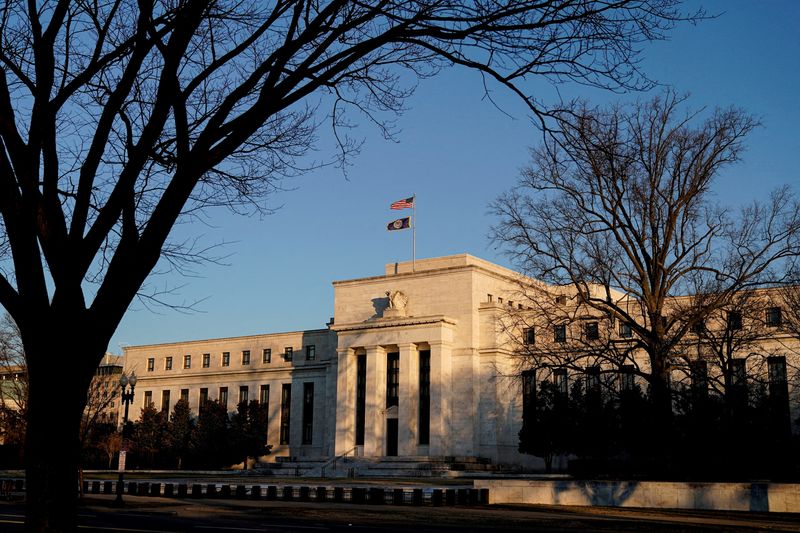By Michael S. Derby and Howard Schneider
NEW YORK (Reuters) -Federal Reserve officials on Wednesday said more interest rate rises are in the cards as the U.S. central bank presses forward with its efforts to cool inflation although none were ready to suggest that January’s hot jobs report could push them back to a more aggressive monetary policy stance.
Moving to a federal funds rate of between 5.00% and 5.25% “seems a very reasonable view of what we’ll need to do this year in order to get the supply and demand imbalances down,” New York Fed President John Williams said at a Wall Street Journal event, adding that the Fed would probably be able to take “smaller steps” this year relative to the pace of much of the tightening campaign.
Williams’ comments were his first since the Fed’s decision last Wednesday to moderate the pace of what had been a historically aggressive rate hike campaign to reduce high inflation. Williams serves as vice chair of the rate-setting Federal Open Market Committee, which boosted its benchmark overnight rate by a quarter of a percentage point to the 4.50%-4.75% range.
The Fed’s rate hike was followed just days later by surprisingly strong January jobs data that suggested the central bank may have to raise rates even more as it seeks to better balance strong demand with available supply in the economy.
Speaking on Tuesday, Fed Chair Jerome Powell said “if we continue to get, for example, strong labor market reports or higher, higher inflation reports, it may well be the case we have to do more” with rate rises over time.
Williams did not signal that the January hiring data, highlighted by a gain of 517,000 jobs and decline in the unemployment rate to a 53-1/2-year low of 3.4%, would necessarily change the rate-hike outlook, nor did he suggest the Fed should have done something larger last week had it known what was in the jobs report.
As the Fed is “likely to be closer to where the peak interest rate is going to be this year, we can take smaller steps still to get to whatever we need to get to,” Williams said.
KEEPING THE BRAKES ON
Speaking to the Joint Center for Political and Economic Studies, Fed Governor Lisa Cook said “it is appropriate to move in smaller steps while we assess the effects of our cumulative tightening in the economy and inflation.”
Cook also said the strong job gain coupled with moderating wage growth last month had increased hopes for a “soft landing” scenario in which the central bank can tame inflation without triggering a recession. She added that she believes the central bank’s work to bring inflation back to its 2% target “can be accomplished without a large increase in unemployment.”
Inflation, based on the Fed’s preferred measure, is running at more than double the target.
In remarks to an Arkansas State University conference, Federal Reserve Governor Christopher Waller said there are signs the central bank’s rate rises are starting to pay off, but he noted that economic data has not been cooling off quickly enough. He also said that while wage growth has slowed, the decline is “not enough,” adding “the Fed will need to keep a tight stance of monetary policy for some time.”
Meanwhile, Minneapolis Fed leader Neel Kashkari, who has a voting role on the FOMC this year, said in remarks in Boston that he still believes the federal funds rate will need to go as high as 5.4% or even further if the data called for it.
Fed forecasts in December, which will be revised next month, eyed a 5.1% stopping point for a rate rise campaign that started with near zero interest rates in March of last year.
Williams, in his remarks, reiterated his belief that it remains key for monetary policy to get to and stay at levels that will restrain economic growth “for a few years.” He added that his expectations of future Fed rate cuts are driven mostly by a need to respond to the likelihood of lower levels of inflation in the future. Fed forecasts from December showed the central bank lowering rates next year.
“If you think about 2024, with inflation coming down, if we don’t cut interest rates, at some point the real interest rate, the interest rate adjusted for inflation, will continue to go up” and in practice make monetary policy even more restrictive, he said. Lowering rates when inflation cools is ultimately about keeping monetary policy in the same place of economic restraint, he said.
(Reporting by Michael S. Derby, Howard Schneider, Lindsay Dunsmuir and Ann Saphir; Editing by Paul Simao and Andrea Ricci)
